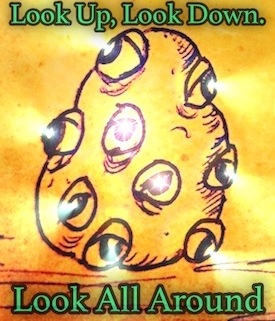Evidence = The thing or things that furnish proof.
Proof = Something that establishes the validity of truth.
Truth = A body of real things.
Real Things = Evidence.
Okay, now that we’ve established the fact that evidence is/are real things that offer proof of the truth, let’s examine a few places where police investigators sometimes find those real things.
Above all, though, before beginning the death scene investigation detectives should first check for signs of life. There’d be nothing worse than wrapping up a crime scene investigation and then have the victim sit up and tell you that you’d missed the most obvious clue of all … a heartbeat.
The savvy detective knows to always look up, down, and all around. After all, tunnel vision can be a cop’s worst enemy in more ways than one. Detectives also know to never smoke, chew gum, eat, or drink while inside a crime scene, and that’s because doing so could deposit “real things” that crime scene techs could be confuse with actual evidence, such as cigarette ashes or a gum wrapper.
And, since there are no “do-overs” with a crime scene, you only have one shot at it before the scene is forever altered. Remember Locard’s Principle from yesterday’s article—“always, without fail, when two objects come into contact with one another, each of those objects will take something from the other or leave something behind.”
A head-to-toe visual exam of the body/victim includes making note of its position and if there’s something abnormal, such as an arm or leg in an unnatural angle. The eyes. Are they open or closed? Any obvious signs of a struggle. Defensive wounds on the hands?
Check for lividity. Is it fixed? If so, where does it show up. Lividity, when present, should appear at the lowest points of the body. If not, that’s an indication that the body was moved after death.
Lividity
Lividity, aka Livor Mortis is the pooling of blood in the lowest portions of the body. It’s caused by gravity and begins immediately after death. The telltale signs of livor mortis, the purplish discoloration of the skin, begins the moment the heart stops pumping. This process continues for approximately 6-12 hours, depending upon surrounding conditions, until it becomes fixed, permanently staining the tissue in the lowest parts of the body. When large areas become engorged with lividity, the capillaries in those areas sometimes rupture causing what’s known as Tardieu spots. Tardieu spots present as round, brownish blacks spots.
Lividity can help investigators determine an approximate time of death. The staining of tissue normally begins within the first two hours after death. The process reaches it’s full peak (fixed) in eight to twelve hours.
If the victim is moved during the first six hours after death the purplish discoloration can shift, causing the new, lowest portion of the body to exhibit lividity.
After a period of six to eight hours after death, when lividity becomes totally fixed, the patterns of discoloration will not change. Therefore, investigators know a body found lying face down with lividity on the back, has been moved.
Rookie officers have often confused lividity with bruising caused by fighting.
Remember, ambient air temperature is always a factor in determining the TOD (time of death). A hot climate can accelerate lividity, while a colder air temperature can slow it down considerably.
Missing Jewelry
Before bagging the hands (use paper bags) to preserve any evidence that may be located around and beneath the fingernails, investigators should carefully examine the hands and wrists, visually, making note of marks or other indications that jewelry had been worn, such as a tan line or indentation on the ring finger. This is a sign that robbery could have been the motive for the death. And that the missing items may appear on an upcoming pawn shop daily report. In most areas, pawn shops are required to submit a daily list of all items purchased. This aids police in tracking down stolen merchandise.
Paper bags are used for bagging the hands because plastic aids in the incubation process of bacteria and, as you know, bacteria growth accelerates decomposition. Bacteria can also destroy DNA.
Alternate Light Sources (ALS)
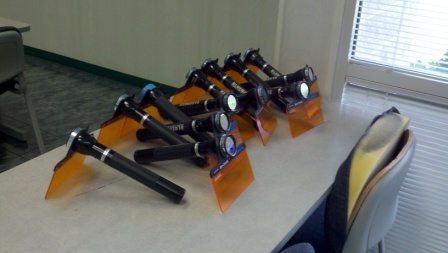
The use of various alternate light sources are used to detect stains and body fluids, fibers, and even fingerprints, all evidence that’s often not visible to the naked eye.

ALS equipment/RUVIS – Sirchie ~ 2018 Writers’ Police Academy
RUVIS (Reflective Ultraviolet Imaging System), a system of locating latent (invisible) fingerprints) without the use of powders, fumes, or chemicals, was developed by Sirchie Fingerprint Laboratories, a sponsor of the Writers’ Police Academy, and the U.S. Army. The system focuses on one specific section of shortwave ultraviolet light, the germicidal spectrum of light, which cannot be seen by the naked eye.
A particularly unique feature of RUVIS technology is that it works in both total darkness and in bright sunshine, a must for use by police investigators.
Sirchie’s Krimesite Imager uses RUVIS technology to detect invisible residues from fingerprints. Those residues reflect UV light projected from the device, which immediately captures the reflections with a 60mm UV lens. A built-in scanner then converts the images to visible light, allowing the investigator to see the fingerprint. All this is done instantly, in real time. And, the detective is able to see images from up to fifteen feet away.
Once the print is located, the investigator uses the Imager to photograph it and, with the use of a micro-printer, print a copy of the desired evidence. All this without the messy powders that never seem to wash away. The KS Imager can also be used to greatly enhance prints developed using cyanoacrylate fuming (Super Glue).
*By the way, keep your eyes and ears open for a major announcement regarding the Writers’ Police Academy and Sirchie. You are going to lose your minds when you hear the news!
Bloodstain Patterns
Characteristics of a blood drop
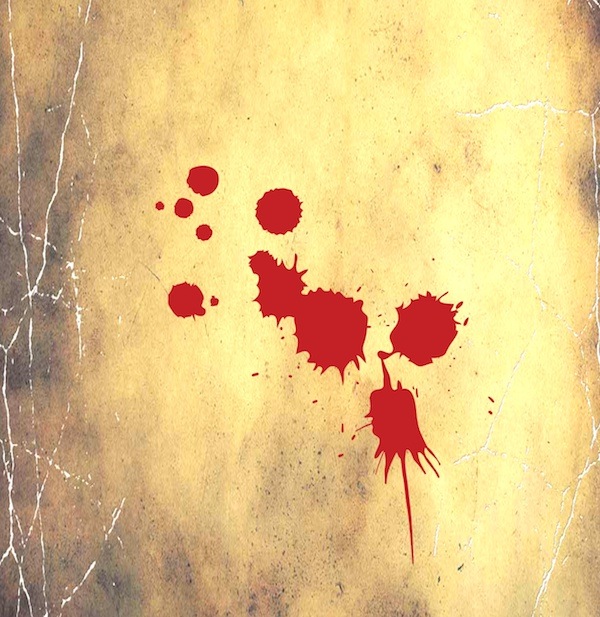
- blood drops are formed by gravity
- blood drops cannot break apart unless contacted by an outside force
- larger drops travel further than smaller drops (due to mass, not size)
- blood drops always travel in an arcing path (impact injuries)
- size ranges from a few millimeters to few centimeters
- volume of a drop of blood is in direct proportion to whatever it’s dropping from (ax, stick, arm, leg, etc)
Crime scene investigators typically measure bloodstains that hit surfaces on the way up, not stains made by blood that’s on its way back down. Stains made when traveling upward are much more accurate for use as evidence because gravity is not as much of a factor in the pattern’s formation.
Types of Bloodstain Patterns
Impact – caused by high-velocity or medium-velocity wounds—gun shots or blows by an object such as a baseball bat or hammer.
Swipes (Wipes)– Caused by a bloody object being wiped across another surface. These stains are the reason for changing the name of the examination from “blood spatter” evidence to “bloodstain” evidence (not all patterns are caused by airborne drops of blood). Remember that in your writing. Patterns caused by spattering, splattering, or wiped-on blood is no longer called “blood spatter.”
Therefore, your characters should reflect the change, as have their real-life counterparts. An example of the change:
Detective Sergeant Catchemall studied the bloodstain pattern on and next to the ticking cow clock hanging on the kitchen wall. He stood there, staring, for what seemed like an eternity before turning toward his partner, Ridley Perkins. Then he tipped his bald, oval-shaped head back toward “the cow wall” where reddish splotches and dots of once-oozing blood contrasted sharply against the freshly painted, snow white surface. The cow’s tail moved from side to side with each tick-tock of the timepiece.
Tick Tock …
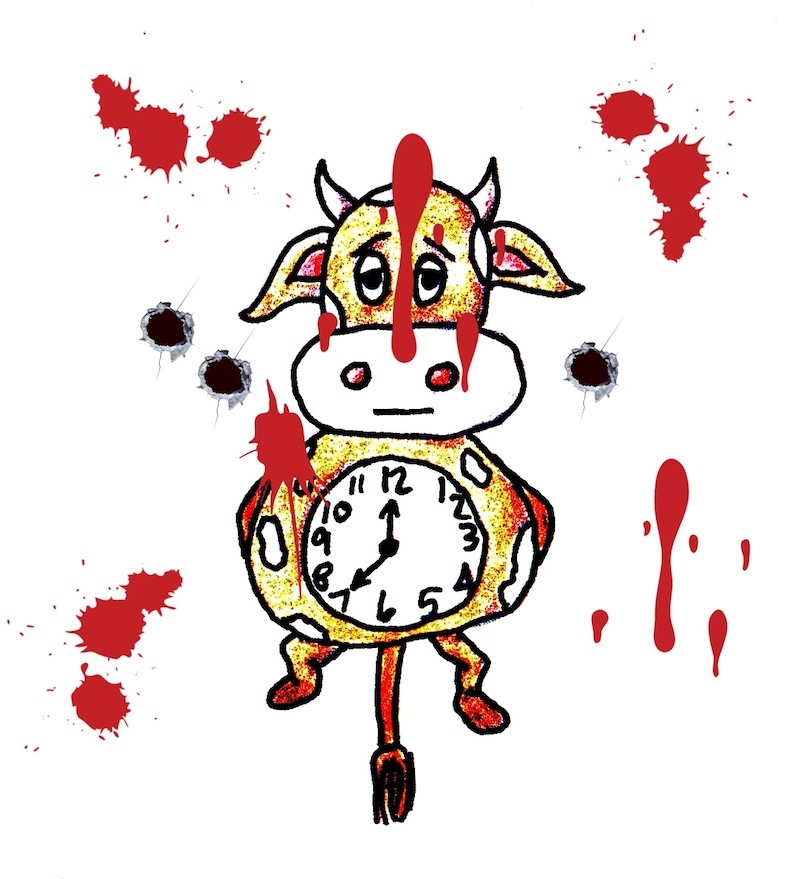
“I believe, Ridley,” he said, “that our killer was right-handed, shorter than your own meager five-and-a-half feet, and was standing, not sitting, quite close to our victim, poor Mrs. Ima Ghostnow, when he pulled the trigger on what was most likely a revolver. That, my friend, is what I believe happened to our unfortunate victim.”
Tick Tock …
*Terminology could vary from one area to the next.
The Lingo
Cast-Off– Caused by slinging blood off objects in motion (a swing of a bloody hammer, or arm).
Drip and Flow– Caused when blood drops off one object onto another.
Projected– Caused by arterial spurts. Often seen in stabbings and cuttings.
The ability to effectively interpret bloodstain patterns is a science and an art. But, before investigators can dive into a crime scene, they must learn a bit of terminology, such as:
Angle of Impact– the angle formed between the direction of an individual drop of blood and the surface it strikes.
Back Spatter– blood that’s directed back towards the source of energy, such as a hand holding a firearm, or hammer.
Expirated blood – blood that’s forced from the mouth or nose where air (exhalation) is the propellant.
High Velocity Impact Spatter (HVIS)– bloodstain pattern caused by a high velocity impact, such as those caused by gunshots or fast moving equipment or machinery (saws, drills, etc.)
Point of Convergence – the point (two dimensional) where the direction of travel (blood droplets) intersect. Can be used to help determine where the victim was standing when the fatal injury was delivered.
Point of Origin –the point (three dimensional) where the direction of travel (blood droplets) intersect.
Stringing – a method used to determine the point of origin. Investigators tie strings at the blood drops, following the direction of travel. The point where the strings intersect is the point of origin. Lasers are sometimes used in lieu of strings.
Always look up, down, and all around
As I stated earlier, this rule of thumb is extremely important when search for evidence and it’s especially so when examining a scene for blood spatter. This includes the undersides of table tops and seat bottoms. The insides of door frames and windowsills. In fact, a peek inside a refrigerator can sometimes save the day when all else come up empty.
Yes, bad guys sometimes cannot resist the urge to grab a quick snack or something to drink while taking a break from dismembering their latest victim. Therefore, it’s not at all unusual to find a bloody fingerprint on the container of onion dip, or loose hair from the head of the killer that’s lodged between the Swiss cheese and plate of leftover hotdogs.
Spatter is often found on ceilings and overhead lighting. On doorknobs and bedroom slippers that sit by the fireplace.
Other bits of often overlooked evidence can be found under rugs or carpeting, behind light switch covers …
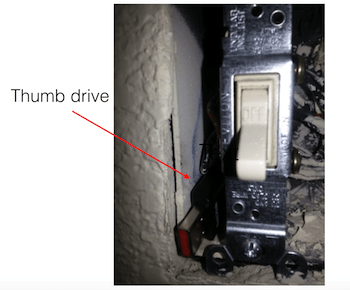
Removing the plastic wall cover to reveal a thumb drive concealed inside the electrical box housing wall light switch.
… inside statues, faux spray cans, sewn inside the hem of clothing and bath towels, inside appliances and handheld electrical gadgets, shoes and, well, you name it and a crook has probably hidden something there.
Locating evidence in an outdoor crime scene – this, my friends, is a topic for another day. In the meantime, remember to have the heroes of your stories to “always look up, down, and all around, because without fail, when two objects come into contact with one another, each of those objects will take something from the other or leave something behind.”
The evidence, proof and truth of the crime and who committed it, is always there. It’s up to the detective to find it.

